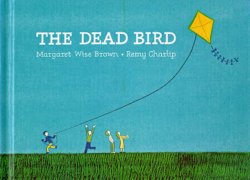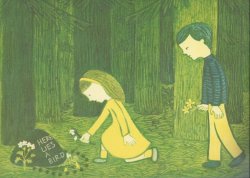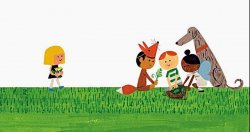
Artwork by Remy Charlip from The Dead Bird © 1965 by William Morrow & Co


Reviewed By Peter Shea
Children come upon a bird that has just died. It is still warm. They bury it, sing a song they have made up, and plant flowers. They visit the grave every day to put fresh flowers on it and to sing to the bird, until they forget. This is the story of Margaret Wise Brown’s The Dead Bird. I imagine that it might leave children who hear it perplexed, at loose ends, uncertain how they are supposed to respond. Usually, books read out in story time or used in class have a direction, a moral, or some internal puzzle to solve. The adults have something in mind, with those stories. But it is hard to sniff that purpose out, here. It has no adults in it, except remembered adults, adults who do things when something dies:

Artwork by Remy Charlip from The Dead Bird © 1965 by William Morrow & Co
The children imagine themselves acting in grown-up roles, but what they do is not like adult funerals. First of all, adults generally don’t do funerals for non-humans. Adults might do a sort of play-funeral for a pet, but not for an anonymous bird, a bird people just happened to find. Those accidental deaths are outside the range of sympathy for most adults. And the human funerals are often about comforting or reassuring those left behind, and celebrating the accomplishments of a life. This service is addressed to the bird, mentioning only what it shared with every other bird
What the children do is purely about death and loss, about the beauty of the living bird. This is a verse from their song:
The children cry at their memorial, because the bird is dead, and because their song is beautiful. They are happy to be able to do this service for the bird.
I can see children standing in various relations to this story. Some may have done something like this. Some may remember other ways of responding to a death, and may find this response strange by contrast: “They didn’t even know the bird.” “They don’t have anything to hope for, in this story.” Some may not have encountered death yet, and my find the whole idea of a memorial puzzling: “This doesn’t make any sense. Why do a service for something that is no longer alive? They probably didn’t notice the bird when it was alive. It would make more sense to put out extra bird seed for the birds who are still living, if they want to do something positive.” I can imagine a class in which some children like the story very much and cannot quite say why, and others find it bothersome or offensive, and cannot quite say why. The challenge in leading a discussion is to make space for such different responses, and also to feel out what question might be most important to this group, at this time.

Artwork by Remy Charlip from The Dead Bird © 1965 by William Morrow & Co
When I teach Confucian ethics in general ethics introduction courses, I begin by asking students for stories of rituals that are important in their lives. Almost every student has such a story. Once they are clear about their own commitments, they can begin to understand what Confucius might mean by putting ritual at the center of a decent life. It might be helpful to ask that kind of question early on, in discussing this story: which of your experiences come closest to what is pictured here?
The rituals my ethics students describe are long established customs, inviting them in. The Dead Bird is about how a new ritual happens, spontaneously, out of a shared experience of grief, expressing a shared reverence for one kind of life. The children are thinking, in a way: they are keeping something in mind for a long time, in a beautiful form. But their thinking is not investigation; it doesn’t make the kind of progress that an argument makes. They repeat the initial experience, again and again, until, as they book says, “they forget.”
One might question this story from various directions, asking, for example, how the children’s service is different from adult rituals around death (or other endings, like graduations), or what idea the children have about the bird that makes it seem important to do this, or how the children are likely to be affected by doing this, day after day, or perhaps even: are there occasions when we might want to compose a ritual response to an event that moves us? (And what kinds of events call for a ritual response?)
One distinctive feature of the children’s action is that it is repeated. The children keep going back to the bird’s grave, singing the same song, day after day. One might wonder about the importance of that repetition, in contrast to actions that are done just once. What does repetition mean, or what does it do for us, to go over the same fact, and the same feelings, many times?
Matthew Lipman’s starting question for philosophic discussion was always, “What’s worth talking about, here?” The Dead Bird may require more restraint from leaders than other stories, so that children can find their own ways into the realities of meaning-making and grief and poetry and shared experience. Different groups may find very different things worth talking about, in this small and exquisite story.
Note: the illustrations in The Dead Bird are worth some thought. The illustrator of the 1965 edition was Remy Charlip, who made muted, sad, thoughtful pictures. Christian Robinson, the illustrator for the 2016 edition, uses brighter colors and portrays a more diverse group of children. Looking at the two versions side by side raises fine questions about how artists make their choices and about how pictures change our experience of texts. It could be valuable to some children to become aware of the power of pictures to change the mood of a story. (The earlier version of the story is available at The Open Library.)

Artwork by Remy Charlip from The Dead Bird © 1965 by William Morrow & Co